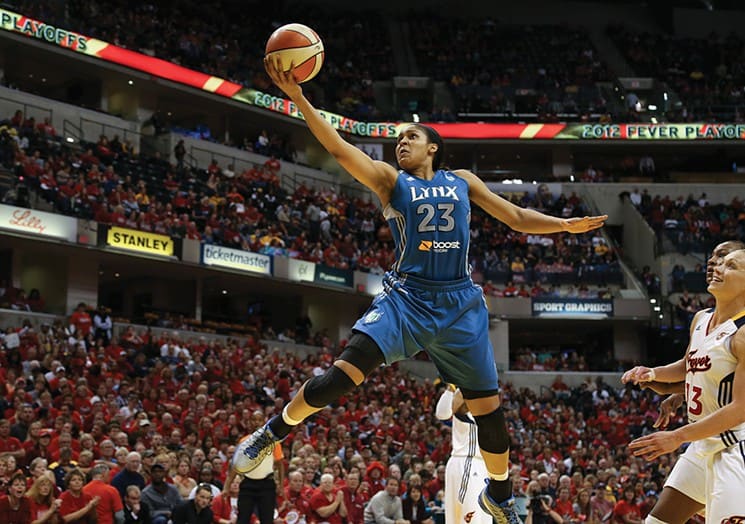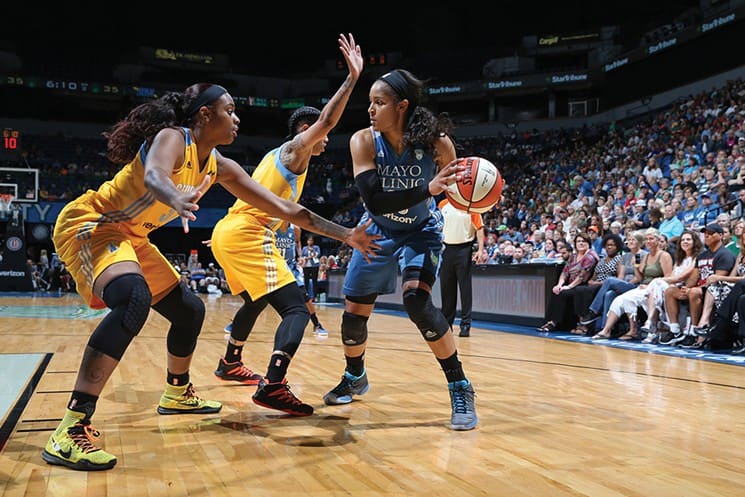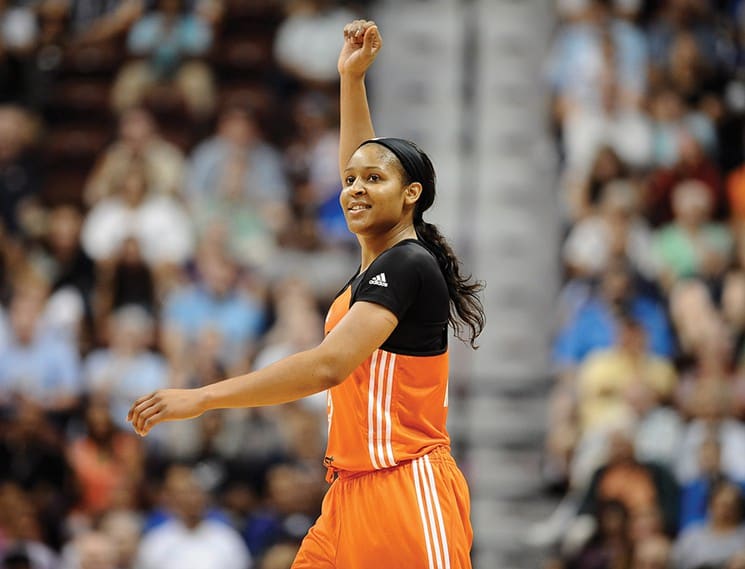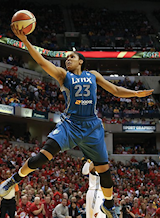Halftime at a Lynx game. Friday night. Late May.
A guy from St. Louis Park, early 30s, walks through the Target Center concourse. He’s wearing a blue Lynx jersey, No. 23, “Moore” across the back.
That’s not Mary Tyler. It’s Maya. Yet this young woman also has the skills to take a nothing day and suddenly make it all seem worthwhile.
The guy, Charlie McChesney, wasn’t a basketball fan. Like many others in the State of Hockey, he grew up cheering for the North Stars, Gophers, and Wild.
Some buddies gave him the Maya jersey as a gag gift before he got married. Now he wears it all the time. “You have to go with a winner,” he says.
He gets it. That’s Maya in a word: winner.
Since she came to town in 2011, the Lynx have won three championships in five years. That’s a big deal. Minnesota hadn’t won a professional championship since the Twins’ World Series victory in 1991 — a quarter century ago. But Los Lynx — as their fans affectionately call them — have transformed Minnesota from a land of also-rans into the home of champions.
Moore has not done it alone. She has some very good teammates in Lindsay Whalen, Seimone Augustus, Sylvia Fowles, Rebekkah Brunson, and Janal McCarville, plus an all-star coach in Cheryl Reeve. Yet good as they are, it’s Maya who leads the team — in minutes played, points scored, and inspiration.
No one carries Maya’s winning pedigree.
At Collins High in suburban Atlanta, she won three state championships. At the University of Connecticut, she won two national championships and led her team on a 90-game unbeaten streak. As a member of the U.S. national team, she has won five titles, including the Gold at the 2012 Olympics. Playing overseas in the winter season, she has won three league championships. Plus those three WNBA championships with the Lynx.
That’s 16 championships in 12 years.
The ancient Greeks would have known her as Nike, “the goddess of victory.” We have never had a winner like her in our midst.

Pregame, the clock winding down on the 60-minute warm-up period, Los Lynx have headed into the locker room. Only Maya and Rebekkah Brunson remain, both still shooting, moving around the court, working the angles, seemingly locked in a duel to see who can outlast the other. With fewer than two minutes remaining, Maya finally walks off, but stops at a railing to sign autographs for a dozen kids clustered there.
Brunson has to usher her away. “Maya, we only have 20 seconds,” she calls. Maya follows at a trot, high-fiving fans along the corridor. They cheer.
Even if you just caught a glimpse of her, the moment tells you so much about Maya. For starters, she’s one of the best players in the world — on her way to becoming the greatest — but she hasn’t forgotten how she got there. She’s still working hard, still consciously trying to improve her game.
She can hardly talk to a reporter these days without mentioning efficiency, which can mean many things, she explains — minutes played, shots made, relating to teammates.
Most often, it’s taken to mean 50/40/90, shorthand for shooting, three-point, and free throw percentages. It’s the gold standard of excellence. Through the Lynx’s first 23 games of the 2016 season, Maya hit 46/38/88. That’s not just natural talent talking; that’s the result of the time she spends trying to improve her game.
When she pauses to sign autographs, it doesn’t seem like she’s fulfilling some perfunctory requirement. She comes across as genuine. She’s got a game to play, but she’s taking time, chatting, smiling, signing whatever is passed her way. She cares about the fans, knows the importance of being there for them. She does not rush. Instead, she has to be urged by her teammate to get to the locker room.
You can hear the love in the cheers as she runs down this corridor, later during the player introductions, and every time the public address announcer calls her name. She is talented, charming, enthusiastic, and virtuous. As the converted hockey fan McChesney says, “What’s not to like?”
It started with a single mom trying to figure out how to cope with a three-year-old in perpetual motion throughout a small apartment in Jefferson City, Missouri. Mom hung a mini-hoop on a door to contain the girl’s energy. Young Maya dunked for hours. Every time she slammed the ball through the hoop — wham! — she tasted joy.
Or, for those who favor genetic over environmental influences, it started when mother Kathryn Moore, who played volleyball at Occidental College, hooked up with former Rutgers star Mike Dabney, who led his school to the NCAA Final Four in 1976.
Dabney eventually married another woman and had two more daughters. He was not part of Maya’s childhood, nor does she like to talk about it. “That’s personal.”
Either way, the summer Maya turned eight years old, the seeds of her destiny took root. That’s the summer, 1997, that the WNBA started.
Maya watched games on television. The first wave of stars — Cynthia Cooper, Sheryl Swoopes, Tina Thompson — became part of her vocabulary. She sported a Houston Comets T-shirt and Swoopes’ signature shoes. She had outgrown the mini-hoop and got her first real one, the kind you anchor with sand.
Maya spent hours practicing in her driveway. She learned to angle the ball just right off the curb so it bounced an alley-oop pass she could stuff. She played other sports — roller hockey, touch football, gymnastics, and soccer — but she remembers a day that year when she skipped soccer practice so she could stay home to shoot hoops.
“That was a defining moment,” she says. “I started to understand basketball was my favorite game.”
More significantly, she glimpsed the career path the WNBA blazed. “Knowing that being a basketball player was okay, as a female, it was cool, it was exciting,” she says. “You could say, ‘I want to be a pro basketball player,’ and it was possible. We had a place.”
When Maya was 11, Kathryn received a promotion at the phone company. The family of two relocated to Charlotte. But the company downsized a year later. Kathryn found a job with a bank and moved to suburban Atlanta.
Maya enrolled at Collins Hill High School in Gwinnett County. Though she became the state runner-up in the high jump, she abandoned track and field to devote herself to basketball. By then, she had won her first Georgia state basketball championship, been named to USA Today’s freshman and sophomore All-America teams, and become the most widely recruited high school prospect in the country.
During her career, Collins Hill would go a stunning 125-3. Just as impressive: Maya graduated with a perfect 4.0.
She committed to UConn, where she became a national sensation. Maya was named an All-American all four years — only the second player in history to pull that off. She won three Wade Trophy Awards as the nation’s best player. She set a gazillion school, conference, and national scoring records. She was also named an Academic All-American.
Perhaps most amazing is that she finished college with a 150-4 record, better than anyone else, male or female, has ever done.
Which is how she became a gift to Minnesota. When the Lynx had the incredible luck to win the first pick in the 2011 WNBA draft, Maya Moore was the sweepstakes prize.
Before a game against the Indiana Fever, the team that Los Lynx defeated for its last championship, Maya is all business. On the edge of the court, she rolls her hips and legs on a cylindrical tube. Her expression is locked into serious. She fixes her eyes on a distant point.
It is during this 15-minute window that reporters are allowed to ask questions, something the players don’t seem to like and only begrudgingly tolerate. Maya’s polite. But it’s obvious she does not welcome the intrusion when a reporter (me) approaches.
She’s asked if she feels pressure wearing No. 23, which will always be associated with Michael and is currently shared by LeBron James.
“If you’re not doing well, maybe.” In other words, no.
She says she writes in her journal about the dynamics on the team, her family, relationships, and has thought about writing a book. But when I ask her plans for the holiday weekend (it’s Friday night of Memorial Day weekend), she responds, “When you’re in season, you don’t think that far ahead.”
All business. Her obsession with winning has made her borderline ascetic.
“Winning is a lifestyle,” she said a week earlier at practice. She sat on a folding chair, gulping a Vega protein drink and chasing it with lemon-lime Gatorade. She cares for her body meticulously, whether it be lifting, stretching, icing, sleeping, or eating.
You’re not likely to bump into Maya at Southdale or First Avenue. She lives in a St. Louis Park apartment complex where most of the players live. Her ideal night is hanging with friends or family, listening to music, eating good food. She was born again when she was 12 years old, and the Lord remains foremost in her life. Her worst vice is red velvet in any form: cake, cupcakes, cheesecake.
After she’s done playing basketball, she aspires to marriage and motherhood. She sees herself “taking joy in that journey. A woman doesn’t have to be working outside her home to be a success.”
Does she have someone in mind as that future husband? This is a source of much curiosity for her fans. But she swats away the question with a firm tone. “That’s personal.”
She is also hyper-competitive. Doesn’t matter if it’s a silly dance competition in the locker room, a power shoulder exercise in the weight room, or a game of cards at Coach Reeve’s house. Maya wants to win. “She is a competitor and wants to win at all costs,” says teammate Seimone Augustus.
“It’s how I’m wired,” Maya admits. “I like to do my best in everything I do.”
Coming from someone else, someone perhaps out to one-up others or someone with an insolent swagger, this might sound obnoxious. Coming from Maya, it doesn’t.
She’s quick to credit coaches, teammates, and God. Her modesty seems sincere, but does not compromise her competitiveness. Missing consecutive three-point shots during warm-ups visibly pains her, and she does not smile when asked if losing in the China playoffs, where she played this past winter, was made any easier by losing to her Lynx teammate Sylvia Fowles.
Before the 2015 season, Maya signed a four-year contract. Her contract pays the WNBA maximum wage of $109,500 a year, which is why she and half of the other WNBA players ply their trade overseas in the winter, where they can make as much as 10 times more per season than they do stateside.
Music runs in Maya’s veins. She will burst spontaneously into song. She’s democratic in her love for music, whether alternative, country, jazz, or Christian hip-hop, so long as it’s got a “life-filled message.”
That’s what made special the victory party Prince threw for Los Lynx at his Paisley Park home after their fifth championship last October. She was not a Prince fan per se, but she appreciated his talent in the very personal setting. “I thought it was really cool how he said ‘thank you’ in one of my love languages,” she says.

Maya Moore on parquet is Martha Graham on stage, Toni Morrison on the page, Adele in stereo. She awakens beauty in those who behold her. Elegance graces her game.
Against the Fever, she freezes her defender with a nifty head and shoulder fake, which clears a lane to the basket for an easy layup. Later she spots Whalen open on the perimeter and feeds her a slick pass.
At one point, Maya dribbles through a thicket of defenders in the paint. In another moment, she leaps and stretches — looking like the Jordan profile on her size 13 shoes — to block a shot.
Her highlight comes in the second quarter when she lunges to steal the ball in the Lynx end, loses her footing, and falls to her knees. She somehow maintains control of the ball, then bounces a pass up the line to Whalen. It’s an amazing display of effort, instincts, reflexes, coordination, and skills. Artistic genius.
Throughout the game, Maya’s face expresses a fluid kaleidoscope of emotion, from frustration to elation. Her eyes are large, often cast upward in the beseeching look of a Renaissance saint. Her smile, though, is what stays with you. It’s gripping. Warm. Powerful. An ebullient widening of her face that endures in the mind’s eye.
During pregame warm-ups, she doles out complimentary hand-slaps with the frequency of a State Fair vendor. After the National Anthem, she playfully skips down a line of teammates, bumping into them with mock clumsiness, jostling away their jitters.
When Reeves calls instructions, Maya concentrates on the coach and nods. She signals directions to teammates. When a Fever basket is disqualified by the shot clock, Maya bounces the ball emphatically — Yes! — and applauds her teammates’ defense. She’s the first to fallen teammate Renee Montgomery, who goes down hard and stays down until finally taking Maya’s hand to pull her up.
And when the game ends with a Lynx victory, Maya recruits rookie Keisha Hampton to run from the opposite corner and meet at center court in a celebratory chest bump.
What we call leadership, Maya considers yet another aspect of winning. “There are basketball wins, but then there are relationship wins, with teammates, coaches, friends, competitors,” she says. “There are nutrition wins, eating right. Winning might be a call that doesn’t go our way and how we respond to it. There are many types of wins.”
Los Lynx fans appreciate those nuances. They stand until the home team makes its first basket, boo calls they don’t approve, holler encouragement, count down the last five seconds on the shot clock.
The younger ones dance during timeouts. Everyone rises to their feet to wave their arms for the free T-shirts Prowl and her cohorts toss into the crowd.
The fans don’t head for the exits at the final buzzer, but linger to watch the Lynx dance at center court and hear Maya’s post-game interview, shown on the Jumbotron. Maya is characteristically quick to credit her teammates and thank the fans.
Kaitlyn Berreau, a 14-year-old from Benson wearing a new No. 23 jersey — her mother, Karri, bought it at halftime to reward Kaitlyn for straight A’s — likes Maya because she’s not all about herself. “She’s a team player,” Berreau says. “She makes sure everyone gets the ball.”
Amanda Carter, a middle-aged woman originally from Connecticut, wears a Lynx T-shirt with 23 on the back while praising Maya’s virtues. “She’s a great player, she’s good in the community, she’s a clean player, she’s polite and kind,” Carter says. “She’s the face of the team, even more so than Lindsay (Whalen).”
Maya is royalty. She has not yet been crowned the greatest, but she is heir apparent.
In her first year in the WNBA, she was named Rookie of the Year. By her fourth, she was the league MVP. She was the WNBA finals MVP in 2013 and the MVP of last summer’s All-Star Game. She just turned 27.
Even President Obama bowed to Maya’s greatness. When the Lynx visited the White House in 2014 to honor their second championship, Maya had already been there several times courtesy of her two national collegiate titles and an Olympic gold medal.
“Basically, there’s like a Maya Moore wing in the White House,” Obama joked. “When she comes, we’ve got all her stuff here. She’s got a toothbrush.”
And that was before she had won her third WNBA championship.
By the numbers, she is already the best in her league. She’s off to another phenomenal start this year, named WNBA player of the month for May while leading the Lynx to a perfect 8-0 start. Through June 9, she led the league in scoring at 21 per game.
Numbers can say a lot, but it’s moments that craft the legend. Consider these:
There was the night in Minneapolis, July 22, 2014, when she scored 48 points, a franchise record and second most in WNBA history. Her last point, a free throw with two seconds left in the second overtime, sealed a Lynx victory over Atlanta.
There was a 42-second stretch during last summer’s All-Star Game. The clock stopped for a timeout with 2:51 remaining, Maya’s team (the West) trailing by a point.
Many players phone it in during All-Star games. Not Maya. “We’ve got to win this!” she urged her teammates huddled around her. “We’ve got to win this!”
So she did. In a span of 42 seconds, Maya scored eight unanswered points to put her team up by seven. She finished with an All-Star Game record 30 points, that MVP trophy, and — most important to her — the win.
There were those final 1.7 seconds of Game 3 in the 2015 Finals, the series even at 1-1, the game tied. The Lynx called timeout.
Reeve picked — who else? — Maya to take the final shot. Whalen inbounded the ball to Maya, who faked. Her defender bought it, stumbling off-balance. Maya slid to her right, dribbled once, then jumped from behind the three-point line. She released the ball with 0.4 seconds left. Her shot sailed smoothly through the hoop.
Game, set, match.
There will be more moments. Five years into the league, she is already great, and getting better.
“I’ve seen things this year that I didn’t see last year,” Reeve says. “Her pick-and-roll game, her ball-handling, her passing all continue to improve. Her legacy will be decided on whether she can keep this team winning.”

Game long over, the fans have finally filed out of the arena. The players have some time to themselves inside the locker room. An assistant brings in post-game meals packed in Styrofoam. They sit in front of their stalls and eat hamburgers, chicken sandwiches, salads.
Maya has brought her own meal, a pasta salad she made before the game, but she’s not eating yet. She’s quaffing a Vega protein drink and is eyeing Rebekkah Brunson’s pizza. Brunson offers her a slice. Maya declines with characteristic discipline: “It looks delicious, but I’m going to live through you.”
A trainer wraps a bag of ice to each ankle. Maya’s toenails are painted a light shade of pink. “I was born with big toes,” Maya jokes. “It’s one of my greatest strengths. Gives me that last little spring on my jumps.”
She’s finally able to ease up on the intensity. She left it on the floor, the win’s in the books, but her work’s still not done. She organizes a Memorial Day get-together for the team. There’s also the media to deal with, a half dozen reporters who will soon descend upon her, TV cameras and microphones in her face.
And there’s more ice. The trainer lashes bags to her knees, to her lower back and abdomen. She has no injuries, just the attendant aches that comes with playing at this level, which takes its toll.
Athletes age faster than the rest of us, their bodies worn down by their mid-thirties. The ice is an effort to delay that deterioration. It’s another part of the routine, another moment that factors into her greatness.
“Winning is not always things people can see,” she says.
She understands how legacies are constructed. A champion wins the last game.
If they ever put a statue of Maya on Nicollet Mall, I hope it captures something like this moment:
After the game, once Maya has danced at center court with teammates and a few lucky kids, she is heading off the floor. A little girl will not let her go.
The young fan, maybe three years old, bounds after Maya, jumping with innocent delight. Maya stops, turns. The champion has something left to give.
Maya smiles her bright, beautiful smile and shimmies her shoulders playfully. The girl is mesmerized, ecstatic. It is just the two of them in the arena, immersed in this joyful moment — with the promise of many more.
© John Rosengren
